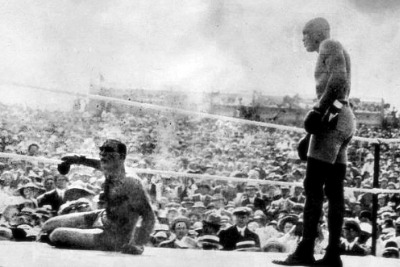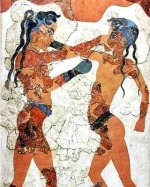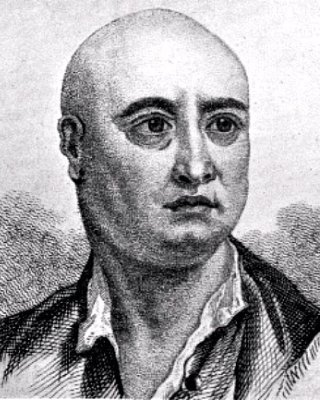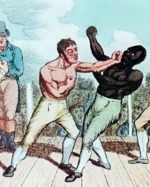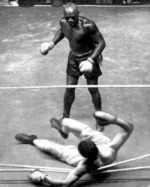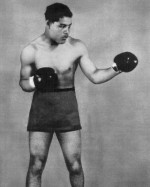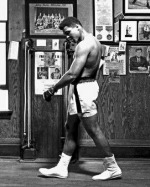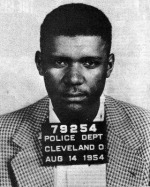Post-Queensbury Rules Boxing Culture
Talk the Talk
Historically in boxing, there were no weight divisions so most fighters tended to be what would today be classed as heavyweights.
However, in the years that followed the
introduction of the Queensbury Rules, a number of new weight categories were introduced.
Though more have been added over the years, the initial ones and their first
champions were
Bantamweight (8st 6lb and under) – First won by George Dixon (USA) in 1888
Featherweight (9st and under) – First won by Billy Murphy (Australia) in 1890
Lightweight (9st 9lb and under) – First won by Arthur Chambers (UK bare-knuckle fighter) in 1847
Welterweight (10st 7lb and under) – First won by Paddy Duffy (USA) in 1888
Middleweight (11st 6lb and under) – First won by Jack Dempsey (USA) in 1884 (Not to be confused with his heavyweight namesake of the twentieth century).
Walk the Walk
When Jack Johnson became the first black boxer in history to win the heavyweight title, a national hunt was sparked to find a so-called Great White Hope who could defeat
him.
Hard men, drawn from many quarters including farms, mines, factories, jails and even straight off the street were trained up and given a shot against the great Jack Johnson,
who dispatched over thirty of them during his seven-year reign as champion from 1908 – 1915.
Boxing Quote
"There is today some brutality connected with boxing ... Certainly it is a highly civilized pastime as compared with the international game of war which
produces so many heroes and national monuments.
Boxing has fallen into disfavour – into very great disfavour. The cause is clear: Jack Johnson ... has out
sparred an Irishman.
He did it with little brutality, the utmost fairness and great good nature. He did not knock his opponent senseless. Apparently, he did not even try ...
Why then this thrill of national disgust? Because Johnson is Black. Of course, some pretend to object to Johnson’s character, but we have
yet to hear, in the case of White America, that marital troubles have disqualified prize fighters or ball players or even statesmen.
It comes down, then, after all to this unforgivable blackness.
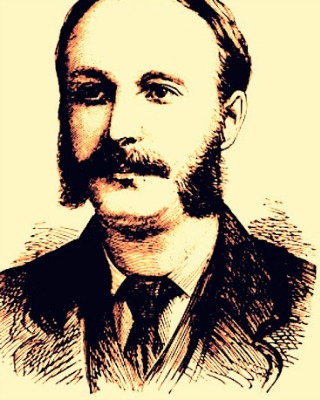
In the nineteenth century, the major development in the sport that made boxing what it is today was the introduction of the Queensbury Rules. Also known as the Marquess of Queensberry Rules, they were sponsored by the Marquis of Queensberry John Sholto Douglas and invented by John Graham Chambers (pictured right).
Prior to this, bare-knuckle boxing was a much more brutal affair with few regulations other than those laid down in the previous century by John ‘Jack’ Broughton. Starting from 1867, the new rules saw boxing gloves used for the first time in professional contests and three-minute rounds were introduced to replace the rule that a round would continue until someone went to ground. The ten-second count was also brought in and a ban on hugging and wrestling moves was added to the prohibition of grasping and hitting below the belt, which was already in place by this time.
Boxing Booths
With the introduction of the Queensbury Rules, boxing began to become legitimised leading to anti-boxing laws being relaxed and less enforced over time. In this environment, the boxing booths that toured America and Britain as carnival attractions flourished, a movement that was pioneered by the former bare-knuckle heavyweight champion Jem Mace.
As a well-loved champ, Mace was in a position to help the new rules take hold. He did so not only as a fighter but also by promoting other boxers and through touring America with his booth and putting on exhibitions demonstrating the new style of pugilism.
In the late nineteenth century and on through to the mid-twentieth century, the popularity of boxing booths grew.
Often no more than a tent with a raised platform in the middle for the bouts, crowds would watch exhibition fights and could even pay to try to go a set number of rounds with a professional fighter; if they won, they would get a prize that amounted to more than a week’s wages for many, though this would probably have been a rare expense for the owner of the booth.
At the end of the show, the crowd would throw coins into the ring or a hat that was passed around and these tips, or nobbings as they were known, would be shared amongst the carnival fighters. While the best boxers could earn a reasonable about of money from the booths, it was hard work with fighters often having to be involved in several shows a day.
In the mid-twentieth century, the various licencing organisations began to restrict the participation and then ban their fighters outright from the boxing booth circuit and by the 1970s, they were a thing of the past.
The Mountain Men
Despite the introduction of the new rules, bare-knuckle fighting still took place amongst some fighters in both America and Britain. One particularly brutal group from Wales were collectively known as the mountain men, most of whom were miners looking to earn extra money though some were full-time fighters. Operating around the turn of the twentieth century, they acquired their name because they usually fought on the side of the Welsh hills and mountains.
A makeshift boxing ring would be set up by putting four sticks in the ground and tying a rope around them and like the fights of the boxing booths, the mountain men would rely on nobbings for payment. Another inventive way they fought was to bury the fighters up to their waist in earth so all they could do was slug each other until one opponent was unconscious, the other being declared the winner.
One of the most feared and respected of the mountain men was Lewis Roderick, whose wrists were so misshapen from his career that when the police tried to arrest him, their cuffs would not go over them. Roderick was unfortunately involved in one too many of these savage fights and ended up going mad. Brain damage and deaths were relatively common on the bare-knuckle boxing circuit and sometimes manslaughter charges were brought against the surviving fighter involved in the illegal contest when things went wrong.
Black Boxers in the Early Twentieth Century
While there had been a long history of black boxers, by the early-twentieth century it was extremely difficult for the best of them to fully reach their potential. Against the odds, Joe Gans won the world lightweight championship in 1902 but was frequently made to lose fights or underperform against inferior challengers who happened to be white.
A few years later in 1908, the American Jack Johnson became the first black heavyweight champion of the world but not before following the former champ, Tommy Burns, all around the world and challenging him at the end of all his tour fights.
When the fight finally happened, Johnson demolished Burns, a victory that was widely considered a national upset.
Everybody from sports writers, fans and even politicians protested the idea of having a black heavyweight champion fearing that Johnson’s victory would cause race riots, a fear that unfortunately turned out to be well-founded.
After defending his title in 1910 against James J. Jeffries, commonly known as the original great white hope (pictured below), there were more race riots in twenty-five states and fifty cities across the country. Twenty-three black people and two white people were reported to have been killed during the disturbances and several lynching attempts were prevented by authorities.
The whole of the white population of America seemed to want Jack Johnson beat in the ring and in a bid to prevent further civil unrest, he would have to take it easy against the other great white hopes he fought for the first seven or eight rounds, before going after the knockout, which he usually achieved. John L. Sullivan, the champion from 1882 – 1892 refused point blank to fight black boxers and after Jack Johnson’s reign, the tradition continued with the likes of Jim Corbett and Jack Dempsey unwilling to fight against the best black challengers; even Johnson drew the colour line as it was more profitable to fight white challengers than genuine black title hopefuls such as Sam Langford.
It can be argued that black boxers only began to be seen as equals in the boxing ring in America after Joe Louis beat the German fighter Max Schmeling in 1938. The press built the fight as a battle between America and Nazi Germany and when Louis won the fight in the first round, he became a national hero for all races and a symbol of the superiority of democracy over fascism. In Britain, the situation was even worse as in 1909, the Lonsdale Belts were set up but excluded black boxers from competing. The ban was not lifted by the British Boxing Board of Control until 1948 when Dick Turpin defeated Vince Hawkins to become the middleweight champion.
Written by Andrew Griffiths – Last updated 23/08/2023. If you like
what you see, consider following the History of Fighting on social media.
Further Reading:
A Few Punches More - The Fairground Boxing Shows. [Internet]. 2007. The University of Sheffield. Available from: http://www.nfa.dept.shef.ac.uk/history/shows/boxing.html [Accessed January 24, 2014].
Boxing. [Internet]. 2013. Encyclopaedia Britannica. Available from: http://www.britannica.com/EBchecked/topic/76377/boxing/229612/Boxings-legal-status [Accessed January 24, 2014].
Holland, G. [Internet]. 2008. History of London Boxing. The BBC. Available from: http://www.bbc.co.uk/london/content/articles/2007/11/13/boxing_london_revival_feature.shtml [Accessed January 24, 2014].
Kent, G. 2005. The Great White Hopes – The Quest to Defeat Jack Johnson. Sutton Publishing. Gloucestershire.
Kent, G. 2009. The Little Book of Boxing. The History Press. Gloucestershire.
Powell, J. [Internet]. 2010. 100 years after his greatest triumph, Jack Johnson's final fight is in the hands of Barack Obama. The Daily Mail. Available from: http://www.dailymail.co.uk/sport/othersports/article-1292193/JEFF-POWELL-Jack-Johnsons-final-fight-hands-Barack-Obama.html [Accessed January 24, 2014].
Ward, G. C. 2004. [Video]. Unforgivable Blackness: The Rise and Fall of Jack Johnson. PBS Home Video. Available from: https://www.youtube.com/watch?v=R_HzLfT-ZuA [Accessed January 24, 2014].
Boxing. [Internet]. 2013. Encyclopaedia Britannica. Available from: http://www.britannica.com/EBchecked/topic/76377/boxing/229612/Boxings-legal-status [Accessed January 24, 2014].
Holland, G. [Internet]. 2008. History of London Boxing. The BBC. Available from: http://www.bbc.co.uk/london/content/articles/2007/11/13/boxing_london_revival_feature.shtml [Accessed January 24, 2014].
Kent, G. 2005. The Great White Hopes – The Quest to Defeat Jack Johnson. Sutton Publishing. Gloucestershire.
Kent, G. 2009. The Little Book of Boxing. The History Press. Gloucestershire.
Powell, J. [Internet]. 2010. 100 years after his greatest triumph, Jack Johnson's final fight is in the hands of Barack Obama. The Daily Mail. Available from: http://www.dailymail.co.uk/sport/othersports/article-1292193/JEFF-POWELL-Jack-Johnsons-final-fight-hands-Barack-Obama.html [Accessed January 24, 2014].
Ward, G. C. 2004. [Video]. Unforgivable Blackness: The Rise and Fall of Jack Johnson. PBS Home Video. Available from: https://www.youtube.com/watch?v=R_HzLfT-ZuA [Accessed January 24, 2014].
More Boxing History
Boxing History Home
The history of boxing dates back in one form or another as far as civilisation itself with ancient Greek boxing even being a part of the early Olympic Games. Modern boxing rules have made the sport safer for the fighters and more entertaining for the crowds, resulting in pugilism becoming one of the most popular athletics events on the planet today.
The history of boxing dates back in one form or another as far as civilisation itself with ancient Greek boxing even being a part of the early Olympic Games. Modern boxing rules have made the sport safer for the fighters and more entertaining for the crowds, resulting in pugilism becoming one of the most popular athletics events on the planet today.
Boxing in the Ancient World
Ancient boxing dates back to the Samarian culture and probably beyond and is known to have also been a part of the Egyptians and Minoan civilisations. It became an event in the ancient Olympic games in Greece in 688 BCE, and ancient Roman boxing was also practiced by athletes, gladiators and Roman soldiers.
Ancient boxing dates back to the Samarian culture and probably beyond and is known to have also been a part of the Egyptians and Minoan civilisations. It became an event in the ancient Olympic games in Greece in 688 BCE, and ancient Roman boxing was also practiced by athletes, gladiators and Roman soldiers.
Boxing in the 18th Century
Modern boxing history really began to develop into the sport known and loved today in the 18th century. Bare knuckled boxing contests began to be regulated and safety measures also began to be put in place. However, the period was also marred by controversy as it saw the first instances of corruption in the form of prize fighters taking payoffs and intentionally losing fights.
Modern boxing history really began to develop into the sport known and loved today in the 18th century. Bare knuckled boxing contests began to be regulated and safety measures also began to be put in place. However, the period was also marred by controversy as it saw the first instances of corruption in the form of prize fighters taking payoffs and intentionally losing fights.
Boxing in the 19th Century
This list of bare-knuckle boxers from the 19th century charts those who are generally accept as being World Champions. It includes some of the best fighters from this period in boxing history starting with Jem Belcher, the first champ of the new century and concluding with Jem Mace, who made the switch from bare-knuckle boxing to using boxing gloves after the introduction of the Queensbury Rules.
This list of bare-knuckle boxers from the 19th century charts those who are generally accept as being World Champions. It includes some of the best fighters from this period in boxing history starting with Jem Belcher, the first champ of the new century and concluding with Jem Mace, who made the switch from bare-knuckle boxing to using boxing gloves after the introduction of the Queensbury Rules.
Sam Langford
Sam Langford, aka the Boston Tar Baby, was one of the greatest boxers never to be crowned world champion. Fighting in the early half of the twentieth century, he was a victim of the colour line in boxing and was not afforded a chance at the title because of the colour of his skin despite the fact that the champion at the time, Jack Johnson, was an African American.
Sam Langford, aka the Boston Tar Baby, was one of the greatest boxers never to be crowned world champion. Fighting in the early half of the twentieth century, he was a victim of the colour line in boxing and was not afforded a chance at the title because of the colour of his skin despite the fact that the champion at the time, Jack Johnson, was an African American.
Joe Louis
Joe Louis (The Brown Bomber) was an American boxer and widely considered to be one of the greatest world heavyweight champions of all time. He became an American hero when he defeated the German Max Schmeling, then later through his work promoting the war effort. Despite his considerable success, later in his career he would face massive debts due to unfair treatment by the taxman.
Little Known Facts About Muhammad Ali
Muhammad Ali was a three-time heavyweight boxing champion and is widely regarded as the greatest boxer of all time, as well as one of the most influential sportsmen of the 20th century. This selection of little-known facts about ‘the Louisville Lip’ show he led an interesting and varied life, both inside and outside the ring.
Muhammad Ali was a three-time heavyweight boxing champion and is widely regarded as the greatest boxer of all time, as well as one of the most influential sportsmen of the 20th century. This selection of little-known facts about ‘the Louisville Lip’ show he led an interesting and varied life, both inside and outside the ring.
The Reign of Don King
Don King is an influential American boxing promoter who has staged some of the biggest fights in boxing history, increased the prize money earned by fighters and considerably raised public interest in the sport, all in his own charismatic and outspoken style. Despite this, King’s career has been constantly marred by controversy leading to him being both loved and hated in the world of boxing.
Don King is an influential American boxing promoter who has staged some of the biggest fights in boxing history, increased the prize money earned by fighters and considerably raised public interest in the sport, all in his own charismatic and outspoken style. Despite this, King’s career has been constantly marred by controversy leading to him being both loved and hated in the world of boxing.
The images on this site are believed to be in the public domain, however, if any mistakes have been made and your copyright or intellectual rights have been breeched, please contact andrew@articlesonhistory.com.

